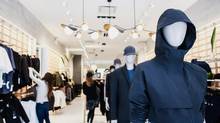
Lululemon’s new lab looks nothing like its 363 other stores around the world. Nestled on a quiet street in New York’s NoHo neighborhood, it’s more posh fashion boutique than yoga pant peddler. Bicycles hang on a wall near the entrance, a nod to the city’s commuter lifestyle; sewing machines sit on tables in the back.
The new store’s unusual design is intentional, and the differences are reflected in its offerings. There’s no sign of the standard yoga pants and stretchy workout tops. Boxy black sleeveless tees, slouchy beige tanks, and monotone waterproof blazers eschew the traditional athletic aesthetic for a more sophisticated, off-duty sidewalk feel. Many items are more fashion-forward, or a bit bizarre, such as a hooded rain jacket that’s cropped at the bust.
The styles, which run from $60 to $450 (U.S.), are totally exclusive to this 2,900-square-foot location. It’s the retailer’s second lab shop, and the first in the United States (the other is in its home city Vancouver). Each lab has its own devoted design team, which releases a new capsule collection every three months. Exclusive collaborations will pop up from time to time. Nothing the store sells is available online, so shoppers must visit in person.
Lee Holman, Lululemon’s creative director, is convinced that these stores can feed his company’s main business. The best new designs, or parts of them, can be integrated into Lululemon’s core clothes. With a particularly active populace and status as a fashion centre, New York was a logical place to begin expanding the lab concept, he argues. It won’t be the last.
“You have other cities around the world where we can get insights, with different climates and fashion trends,” said Mr. Holman. “Where do we want to expand? What cities have a unique point of view that we can learn from? I think it’s just picking those cities that we can really bring back something from.” He declined to share the specific cities on his watch list.
As small shops that boast exclusivity, these stores will never be major drivers of sales. Rather, the labs are a playground for designers to mess around with new ideas. These range from subtle functional details, such as pocket styles or reflectivity, to experimental new silhouettes and fits.
It’s a shrewd marketing play in the face of rising competition, said Bridget Weishaar, an analyst at Morningstar. New athletic apparel labels such as Outdoor Voices, K-Deer, and Alala are flooding the segment, and even Beyoncé has entered the fray with a brand called Ivy Park. These labs allow Lululemon to tout quality with a small-batch vibe, despite its status as a giant multinational corporation. Even if the stores lose money, it’s unlikely to affect the company’s margins. Most of all, it’s flat-out different. “You don’t see other athletic apparel brands doing this,” said Ms. Weishaar. “This is really unique.”
Marcus Le Blanc, the lab’s head designer, said he hasn’t yet received specific directives from headquarters, allowing for a purer creative process. Mr. Le Blanc previously worked at Theory, and it shows in the sleek, sharp lines and muted color palette of the New York store’s clothes. Although his team often visits the Vancouver headquarters to present what it’s up to, the East Coast gear is entirely separate from what’s created in Lululemon’s research and development skunkworks at its home base, where scientists and engineers come up with new fabric tech. Mr. Le Blanc’s designers simply borrow that tech and try to use it in new ways.
“We really look at what’s needed, functionally, for people to get around the city comfortably,” he said. “We allow people to be dressed up while being protected from the elements.”
From: The Globe and Mail
